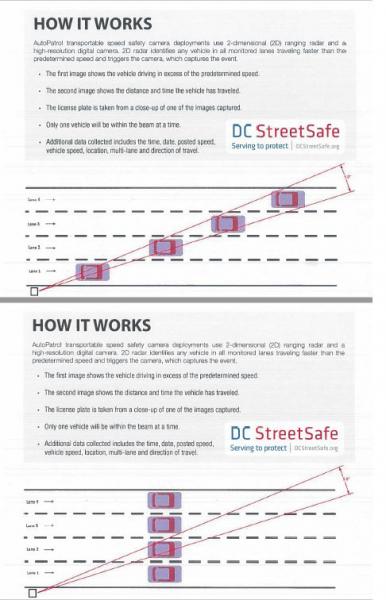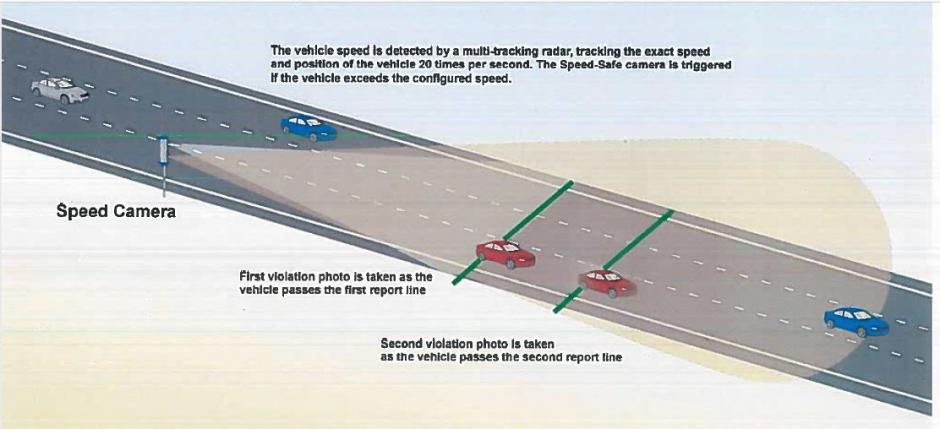
 Although photo radar uses the same Doppler principle as traditional radar, its unique feature is that it transmits a very narrow beam across the road, thereby eliminating the risk of tracking two vehicles at once. Conventional hand-held radar, in contrast, transmits a very wide beam at a very long distance down the road—often requiring the operator to distinguish among speeding and non-speeding vehicles—all traveling at a wide range of speeds. Also with photo radar, the offending vehicle is tracked much closer to the photo radar equipment, generally no more than 100 feet from the photo radar equipment.
Although photo radar uses the same Doppler principle as traditional radar, its unique feature is that it transmits a very narrow beam across the road, thereby eliminating the risk of tracking two vehicles at once. Conventional hand-held radar, in contrast, transmits a very wide beam at a very long distance down the road—often requiring the operator to distinguish among speeding and non-speeding vehicles—all traveling at a wide range of speeds. Also with photo radar, the offending vehicle is tracked much closer to the photo radar equipment, generally no more than 100 feet from the photo radar equipment.
The radar unit may be set up on a tripod, in a fixed installation, in a portable installation or mounted in a vehicle positioned at the side of the road. The MPDC plans to use various types of installations.
The Fixed Installation Pole/ Portable Installation
A 5° wide K-Band Radar beam using Doppler radar is projected at 20° angle across the road from the front of the stationary radar unit. The unit takes 200-300 speed calculations per second. Deployment logs are completed and validated by trained civilian technicians to ensure proper setup, testing, and operations of the unit during the deployment period. When the radar control unit detects a vehicle in the beam traveling at or greater than the speed specified for that location, it instructs the camera control unit to take two photographs of the detected vehicle. The camera will not take a photograph if the system malfunctions. A copy of the certified log, photographs that show the violation and a close-up of the rear of the vehicle will be provided as evidence for any adjudication of a radar ticket.
Technical Note: If the vehicle is traveling toward the radar unit, the returning beam will be compressed. If the vehicle is traveling away, the returning beam will be expanded. How much the frequency is increased or decreased is directly proportional to the speed of that relative motion. What is most important about the Doppler effect is that the frequency change happens only when there is relative motion between the objects. If both objects are standing still (i.e., parked vehicles) there is no relative motion, and the reflected signal has the same frequency as the transmitted signal (e.g., no change in frequency = no speed reading). Police traffic radar merely measures this change in frequency and converts it to a speed reading.
After each deployment, photographs of the speeding vehicles are processed and then reviewed by specially trained technicians or a sworn member of the MPDC. Based on motor vehicle registration data, a Notice of Infraction is created and mailed to the registered owner of the vehicle. Under District law, the registered owner is responsible for paying or adjudicating the citation. Motorists who receive photo-enforced tickets have the same rights to request a hearing and contest a citation as someone who is issued a ticket by a police officer.
